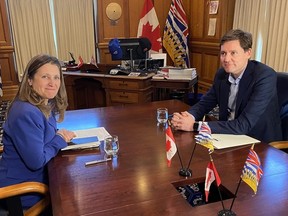Debt payments skyrocketing as spending remains out of control.

Article content
Hold onto your wallets — the Trudeau government looks set to start spending plenty of money once again.
Advertisement 2
Article content
Finance Minister Chrystia Freeland gave that hint when asked what the focus of the federal budget will be when it’s released on April 16.
Article content
“It’s housing, housing, housing,” Freeland said in Victoria, British Columbia on Monday.
That means spending, spending, spending.
The Trudeau government’s main focus on housing has been on the affordable housing side of the equation. Which doesn’t mean making sure that you can afford to buy a home — it means subsidized housing for low-income Canadians.
There is definitely a place for that, but there is no doubt that such a focus costs money and lots of it. This, of course, is all on top of the nearly $100 million in new spending for CBC this coming year plus the costs of newly announced programs like pharmacare.
Article content
Advertisement 3
Article content
Right now, the federal government is already stretched thin and any increase in spending will not only increase the debt and debt payments but also keep inflation higher than it should be. One of the reasons the Bank of Canada didn’t announce interest rate cuts last week and is unlikely to next month is the rate of government spending.
Last week the Parliamentary Budget Officer (PBO) released a report warning that the Trudeau government’s spending plans remain out of control. The amount that taxpayers spend just to service the national debt is expected to go up by 33.4% this current year and 11.6% in the coming year.
That means the amount we pay to cover just the interest on the national debt will rise from $35 billion last year to $46.7 billion this year and $52.1 billion next year. It’s important to put those figures in perspective because those debt payments offer no services and rob precious dollars from services.
Advertisement 4
Article content
By next year, the federal government will spend more on debt payments, $52.1 billion, than they do on health transfers to the provinces and territories, $49.2 billion. The debt payments will be 9.3 times the $5.6 billion the Trudeau Liberals are spending to get their $10-a-day child care off the ground.
The debt payments will be double what we will spend on the military.
The PBO also reports that the number of people on the federal payroll has exploded in recent years. From roughly 340,000 people when the Trudeau Liberals took power to 432,000 this year and expected to rise to 439,000 next year.
While the size of the federal workforce has increased by 30%, I’m not sure anyone could argue that service levels have increased by 30%, if at all.
Advertisement 5
Article content
Of course, in addition to spending on staff payroll, the Trudeau Liberals have also increased the federal government’s spending on outside consultants. They’ve gone from $10.4 billion when they took office to $17.7 billion in 2022.
“Reducing the use of external consultants, bringing expenditures closer to 2005-06 levels,” is one of the ways the Trudeau Liberals promised to control spending in their 2015 election platform.
Of course, that was the same campaign where they promised three small deficits to help stimulate the economy. None of the deficits were small and we are apparently still stimulating the economy nine years later.
The PBO said last week that assuming “no new measures are introduced, and existing temporary measures sunset as scheduled, the deficit is projected to resume its downward trajectory.”
The problem is, that won’t be the only new spending — this government seems to grow in all directions at all times.
Bottom line, spending is going up, the debt payments will only get bigger, and those interest rates hitting our own personal budgets will remain higher than they need to be because the Trudeau government can’t get its fiscal house in order.
Article content



